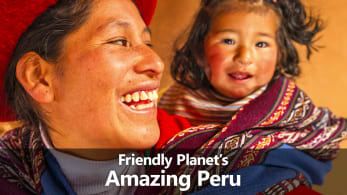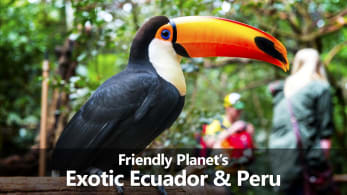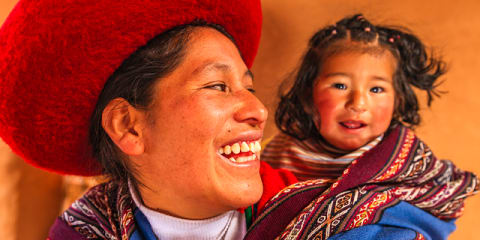 Peru
Peru
Hidden above the clouds, the Incan ruins of Machu Picchu lie cradled among the Andes mountains. A bucket-list item for many visitors. Travel to where archeological ruins echo mighty indigenous cultures. Visit beautiful Lake Titicaca, the largest lake in South America and, according to Andean legend, the birthplace of civilization. Whether you want to trace the mystery about the Nazca Lines geoglyphs, savor the traditional Peruvian delights of Lima after a day of bird watching on the Ballestras Islands, shop for hand-painted beads in the capital city of Cusco, or wander Chinchero in the Sacred Valley (where legend has it the rainbow was born), Peru will leave you breathless.
Highlights
- Machu Picchu
These days, Machu Picchu is synonymous with Peru. These massive ruins, relics of the Inca Civilization, are located in the Cuzco region. Towering almost 8,000 feet above the forest, clouds, and small gateway town of Aguas Calientes, it is fortified like a castle and was built around the year 1450. Translated from the Inca language of Quechua, this citadel means "old peak." Once you've entered the city in the clouds, looking down over the peaceful valley and river below, it's easy to imagine yourself as an ancient Incan king surveying his domain. Also, try imagining the effort it would have taken to transport all the building materials to his perched fortress. For intrepid travelers, you can hike the rock-hewn stairs even further up to Huayna Picchu, from which you can look down onto the ancient city. (And it's a great photo op!) Voted as one of the world's "New Seven Wonders of the World," this site is a must-see!
- Sacred Valley
Nestled in the Andes Mountains and spanning from Pisac to include all of the lands along the Urubamba River to Machu Picchu, Peru's Sacred Valley was a coveted location in the ancient Incan Empire. Desirable for its lower elevation, warmer temperatures, and ability to grow maize in the valley, these conditions were optimal for thriving during the civilization's development. Today, visitors flock to this region to witness the heart of the ancient Inca Empire, explore the quaint colonial villages and the hilltop citadel Ollantaytambo, and shop at artisan craft markets.
- Cusco
Perched high in the Andes Mountains, the city of Cusco is as cultural and charming as it is ancient. Cusco's central plaza is flanked by its iconic two-steeple, red-hued cathedral and surrounded by arched stone shopping and dining promenades. It is as good a place as any in the country to sit, relax, and absorb Peru's rich heritage. Practice your Spanish with local cab drivers and merchants throughout your day. Cross paths with an alpaca. People come to Cusco to get to Machu Picchu, but they stay in Cusco to experience the friendly locals, delicious Peruvian cuisine, and ancient history that the city offers.
- Alpacas
Very common in South America, alpaca herds typically graze in the Andes Mountains of southern Peru at very high altitudes. Regarded as an especially sacred commodity in Peru, alpacas have been viewed as necessary ever since Simon Bolivar signed a decree protecting all camelids, which includes alpacas, llamas, and vicunas, among other animals, in 1827. An entire industry has evolved around the alpaca, as many Peruvian citizens have coveted its fleece over the years. Back during the establishment of the Incan Empire, the fleeces were reserved for royalty, but today, the alpaca fleece is a booming industry and a favorite souvenir for visitors. You'll likely see alpacas grazing lazily at Machu Picchu. In Cuzco, indigenous women will bring their alpacas into town to take photos with the tourists. Just be sure they don't chew your backpacks!
- Lake Titicaca
Straddling the border between Peru and Bolivia, Lake Titicaca is the largest lake in South America. It is also known as the "highest navigable lake" worldwide, with a surface elevation of 12,507 feet. Draped in a legend of its own, Lake Titicaca is thought to be the exact place where Mama Ocllo and Manco Capac, the founders of the Inca Empire, appeared from the deep waters of the lake. Also, Titicaca is home to more than 530 marine species, especially abundant water birds and endangered water frogs. You can take a boat across the lake to visit several of its floating island towns, artificially built by the locals out of buoyant reeds. They live and work on these islands in the middle of the lake.
- Lima
From large urban areas to pre-Incan pyramids, Lima, the "City of Kings," is a place of great contrast. This stately capital was founded on January 18, 1535, in Peru's central coastal region, by Spanish conquistador Francisco Pizarro. As a result, Lima served as an overnight stop for those seeking glimpses of Cusco and Machu Picchu throughout history. Still, today this city is an economic hub and is home to about one-third of Peru's total population. From its fascinating Historical Center and artifacts at the Archaeological Museum of Rafael Larco Herrera to authentic Peruvian dining, Lima is a place with a thousand stories to share.
Fast Facts
Already booked on one of our packages to Peru? See everything you need to know before you go.
| Overview | Capitol: Lima |
| Entry requirements | Please see our Entry Requirements page. |
| Staying Healthy | Malaria According to the CDC, there is no risk of malaria in the highland tourist areas (Cuzco, Machu Picchu, Lake Titicaca) or along the pacific coast (including Lima Province). Yellow Fever The CDC recommends Yellow Fever vaccine for all travelers who will visit Yellow Fever Endemic areas of Peru—including the Amazon. Ask your physician for more information. CDC Guidance by country: Peru Altitude This tour includes some time at high altitudes where travelers may suffer from varying degrees of altitude sickness. Please consult with your physician about any precautions before you depart. |
| Weather | Peru's terrain ranges from desert to jungle and mountain to coast. February and March are generally fair everywhere. Mountains tend to be rainy November to March and Highlands between October and April. Most Peruvians take their vacations from July to September which happens to be when most tourists visit Peru. June through September have the most humidity in Lima, and the Amazon is always hot and humid. Take along a sweater no matter where you are going or what season you are traveling in. |
| Tipping | In restaurants, an 18% service charge is included in the bill if you are paying by credit card. If you are paying in cash, there is no fee; tip 5%- 10%. |
| Money & Credit Cards | Always notify your bank prior to departure to avoid any problems using your credit or debit card while traveling. |
| Shopping | The best items to shop for are ponchos, cotton and linen, blankets, tapestries, pottery, alpaca-wool sweaters and rugs, Inca walking sticks, oil paintings, handmade statues, woven-straw items, silver, leather, and gold. Bargaining is the rule in markets. Avoid purchasing artifacts or antiques as they cannot be exported. Also avoid handcrafts made with feathers, depending on the bird it came from, it could be illegal. |
| Electricity & Power Adapters | 220 volts. Plugs A, B & C. You will need a voltage converter and plug adapter in order to use U.S. appliances. We recommend getting a universal adapter and converter kit. Learn more about electrical standards around the world. |
| Cell Phones & Internet | Want to take your cell phone, tablet or laptop, but not sure how to get cell service or wifi? Read up on using your cell phone abroad and the top 5 ways to get Internet abroad. |
| Did you know? |
|
Videos
Tours & Packages
- Destinations: Peru
- including closed packages


Trip Reviews & Photos
We love hearing your stories and seeing your photos! Check out our entire fan photo gallery and upload your photos.

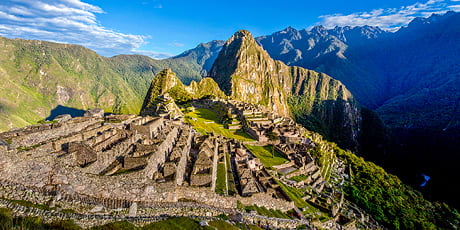 These days, Machu Picchu is synonymous with Peru. These massive ruins, relics of the Inca Civilization, are located in the Cuzco region. Towering almost 8,000 feet above the forest, clouds, and small gateway town of Aguas Calientes, it is fortified like a castle and was built around the year 1450. Translated from the Inca language of Quechua, this citadel means "old peak." Once you've entered the city in the clouds, looking down over the peaceful valley and river below, it's easy to imagine yourself as an ancient Incan king surveying his domain. Also, try imagining the effort it would have taken to transport all the building materials to his perched fortress. For intrepid travelers, you can hike the rock-hewn stairs even further up to Huayna Picchu, from which you can look down onto the ancient city. (And it's a great photo op!) Voted as one of the world's "New Seven Wonders of the World," this site is a must-see!
These days, Machu Picchu is synonymous with Peru. These massive ruins, relics of the Inca Civilization, are located in the Cuzco region. Towering almost 8,000 feet above the forest, clouds, and small gateway town of Aguas Calientes, it is fortified like a castle and was built around the year 1450. Translated from the Inca language of Quechua, this citadel means "old peak." Once you've entered the city in the clouds, looking down over the peaceful valley and river below, it's easy to imagine yourself as an ancient Incan king surveying his domain. Also, try imagining the effort it would have taken to transport all the building materials to his perched fortress. For intrepid travelers, you can hike the rock-hewn stairs even further up to Huayna Picchu, from which you can look down onto the ancient city. (And it's a great photo op!) Voted as one of the world's "New Seven Wonders of the World," this site is a must-see! Nestled in the Andes Mountains and spanning from Pisac to include all of the lands along the Urubamba River to Machu Picchu, Peru's Sacred Valley was a coveted location in the ancient Incan Empire. Desirable for its lower elevation, warmer temperatures, and ability to grow maize in the valley, these conditions were optimal for thriving during the civilization's development. Today, visitors flock to this region to witness the heart of the ancient Inca Empire, explore the quaint colonial villages and the hilltop citadel Ollantaytambo, and shop at artisan craft markets.
Nestled in the Andes Mountains and spanning from Pisac to include all of the lands along the Urubamba River to Machu Picchu, Peru's Sacred Valley was a coveted location in the ancient Incan Empire. Desirable for its lower elevation, warmer temperatures, and ability to grow maize in the valley, these conditions were optimal for thriving during the civilization's development. Today, visitors flock to this region to witness the heart of the ancient Inca Empire, explore the quaint colonial villages and the hilltop citadel Ollantaytambo, and shop at artisan craft markets.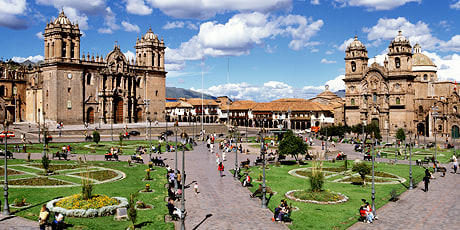 Perched high in the Andes Mountains, the city of Cusco is as cultural and charming as it is ancient. Cusco's central plaza is flanked by its iconic two-steeple, red-hued cathedral and surrounded by arched stone shopping and dining promenades. It is as good a place as any in the country to sit, relax, and absorb Peru's rich heritage. Practice your Spanish with local cab drivers and merchants throughout your day. Cross paths with an alpaca. People come to Cusco to get to Machu Picchu, but they stay in Cusco to experience the friendly locals, delicious Peruvian cuisine, and ancient history that the city offers.
Perched high in the Andes Mountains, the city of Cusco is as cultural and charming as it is ancient. Cusco's central plaza is flanked by its iconic two-steeple, red-hued cathedral and surrounded by arched stone shopping and dining promenades. It is as good a place as any in the country to sit, relax, and absorb Peru's rich heritage. Practice your Spanish with local cab drivers and merchants throughout your day. Cross paths with an alpaca. People come to Cusco to get to Machu Picchu, but they stay in Cusco to experience the friendly locals, delicious Peruvian cuisine, and ancient history that the city offers. Very common in South America, alpaca herds typically graze in the Andes Mountains of southern Peru at very high altitudes. Regarded as an especially sacred commodity in Peru, alpacas have been viewed as necessary ever since Simon Bolivar signed a decree protecting all camelids, which includes alpacas, llamas, and vicunas, among other animals, in 1827. An entire industry has evolved around the alpaca, as many Peruvian citizens have coveted its fleece over the years. Back during the establishment of the Incan Empire, the fleeces were reserved for royalty, but today, the alpaca fleece is a booming industry and a favorite souvenir for visitors. You'll likely see alpacas grazing lazily at Machu Picchu. In Cuzco, indigenous women will bring their alpacas into town to take photos with the tourists. Just be sure they don't chew your backpacks!
Very common in South America, alpaca herds typically graze in the Andes Mountains of southern Peru at very high altitudes. Regarded as an especially sacred commodity in Peru, alpacas have been viewed as necessary ever since Simon Bolivar signed a decree protecting all camelids, which includes alpacas, llamas, and vicunas, among other animals, in 1827. An entire industry has evolved around the alpaca, as many Peruvian citizens have coveted its fleece over the years. Back during the establishment of the Incan Empire, the fleeces were reserved for royalty, but today, the alpaca fleece is a booming industry and a favorite souvenir for visitors. You'll likely see alpacas grazing lazily at Machu Picchu. In Cuzco, indigenous women will bring their alpacas into town to take photos with the tourists. Just be sure they don't chew your backpacks!  Straddling the border between Peru and Bolivia, Lake Titicaca is the largest lake in South America. It is also known as the "highest navigable lake" worldwide, with a surface elevation of 12,507 feet. Draped in a legend of its own, Lake Titicaca is thought to be the exact place where Mama Ocllo and Manco Capac, the founders of the Inca Empire, appeared from the deep waters of the lake. Also, Titicaca is home to more than 530 marine species, especially abundant water birds and endangered water frogs. You can take a boat across the lake to visit several of its floating island towns, artificially built by the locals out of buoyant reeds. They live and work on these islands in the middle of the lake.
Straddling the border between Peru and Bolivia, Lake Titicaca is the largest lake in South America. It is also known as the "highest navigable lake" worldwide, with a surface elevation of 12,507 feet. Draped in a legend of its own, Lake Titicaca is thought to be the exact place where Mama Ocllo and Manco Capac, the founders of the Inca Empire, appeared from the deep waters of the lake. Also, Titicaca is home to more than 530 marine species, especially abundant water birds and endangered water frogs. You can take a boat across the lake to visit several of its floating island towns, artificially built by the locals out of buoyant reeds. They live and work on these islands in the middle of the lake.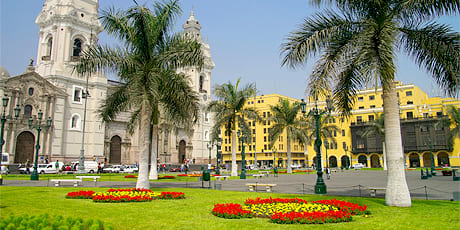 From large urban areas to pre-Incan pyramids, Lima, the "City of Kings," is a place of great contrast. This stately capital was founded on January 18, 1535, in Peru's central coastal region, by Spanish conquistador Francisco Pizarro. As a result, Lima served as an overnight stop for those seeking glimpses of Cusco and Machu Picchu throughout history. Still, today this city is an economic hub and is home to about one-third of Peru's total population. From its fascinating Historical Center and artifacts at the Archaeological Museum of Rafael Larco Herrera to authentic Peruvian dining, Lima is a place with a thousand stories to share.
From large urban areas to pre-Incan pyramids, Lima, the "City of Kings," is a place of great contrast. This stately capital was founded on January 18, 1535, in Peru's central coastal region, by Spanish conquistador Francisco Pizarro. As a result, Lima served as an overnight stop for those seeking glimpses of Cusco and Machu Picchu throughout history. Still, today this city is an economic hub and is home to about one-third of Peru's total population. From its fascinating Historical Center and artifacts at the Archaeological Museum of Rafael Larco Herrera to authentic Peruvian dining, Lima is a place with a thousand stories to share. 